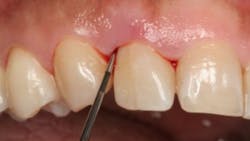Staging, grading, and diagnosing periodontitis
It is apparent that there is some confusion regarding the American Academy of Periodontology’s (AAP) Guidelines for Staging and Grading Periodontitis. Specifically, there appears to be a perception that the guidelines are used to establish the diagnosis of periodontitis for individual patients or to guide treatment recommendations.
What the AAP says
The AAP website states the following:
“The 2017 World Workshop on the Classification of Periodontal and Peri-Implant Diseases and Conditions resulted in a new classification of periodontitis characterized by a multidimensional staging and grading system.”
Regarding staging, the AAP website states:
“Staging intends to classify the severity and extent of a patient’s disease based on the measurable amount of destroyed and/or damaged tissue as a result of periodontitis and to assess the specific factors that may attribute to the complexity of long-term case management.”
Regarding grading, the AAP website states:
“Grading aims to indicate the rate of periodontitis progression, responsiveness to standard therapy, and potential impact on systemic health.”
What the AAP does not say
Notice that the words diagnosis or treatment do not appear in any of these statements, because diagnosing a patient’s periodontal condition necessarily precedes staging and grading. Treatment decisions are determined by the diagnosis. Staging and grading are used solely to describe the severity, extent, and prognosis of periodontitis and does not constitute the diagnosis nor does it determine what treatment options are best.
How is periodontal disease diagnosed?
So, if the AAP guidelines are not a new way of diagnosing periodontal disease, how is it diagnosed and what are the possible diagnoses? To establish a diagnosis, we still need to perform a comprehensive periodontal examination, charting, and radiographs. Once the data is gathered and a diagnosis of periodontitis has been established, then the data can be interpreted within the framework of the staging and grading system to better describe the disease.
The possible diagnoses are health, gingivitis, or periodontitis. That’s it. Establishing the diagnosis is quite simple. If there is any level of bone loss, the patient has periodontitis. If there is no bone loss but there is bleeding on probing (BOP), the patient has gingivitis. If all sulci are 1–3 mm with no BOP, redness, or swelling, the patient is healthy.
If the patient is healthy or has gingivitis, staging and grading does not apply and should not be undertaken. If a patient has periodontitis, then the disease is staged and graded according to the AAP guidelines.
Look at the first quote above from the AAP. It says this is a new way to classify periodontitis. This means that we know the patient has periodontitis prior to establishing the stage and grade. This also applies to the AAP’s quote concerning staging and the statement about grading. They both also require a prior diagnosis of periodontitis.
In our offices, we provide the periodontal evaluation and evaluate the radiographs. The data generated determines the diagnosis of health, gingivitis, or periodontitis, as it has been for decades. Staging and grading only applies to those patients who have periodontitis.
Perhaps the most conspicuous hint is the title; “AAP Guidelines for Staging and Grading Periodontitis”—not “AAP Guidelines for Diagnosing Periodontitis.”
Just something to think about.
Additional reading: The new classification of periodontal disease that you, your patient, and your insurance company can understand
Editor’s note: This article first appeared in Through the Loupes newsletter, a publication of the Endeavor Business Media Dental Group. Read more articles and subscribe to Through the Loupes.
About the Author
Richard H. Nagelberg, DDS
Richard H. Nagelberg, DDS, has practiced general dentistry in suburban Philadelphia for more than 30 years. He has served on many advisory boards and as a consultant and key opinion leader for a variety of companies and organizations. Dr. Nagelberg is the Director of Medical Affairs at OraPharma, a division of Bausch Health US, LLC. His practice and other professional activities are centered on the impact dental professionals have beyond the oral cavity. Contact Dr. Nagelberg at [email protected].
Updated May 2022


